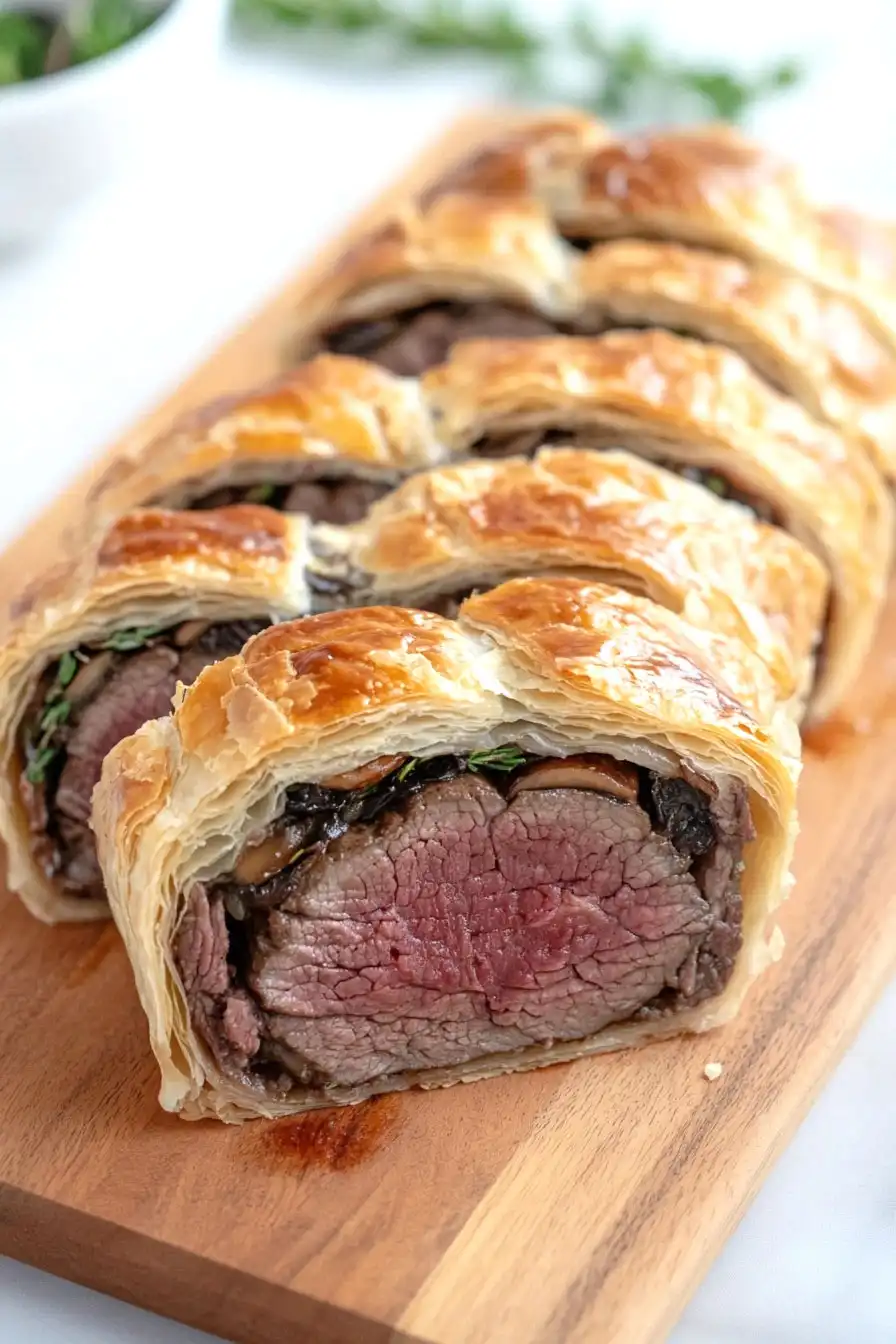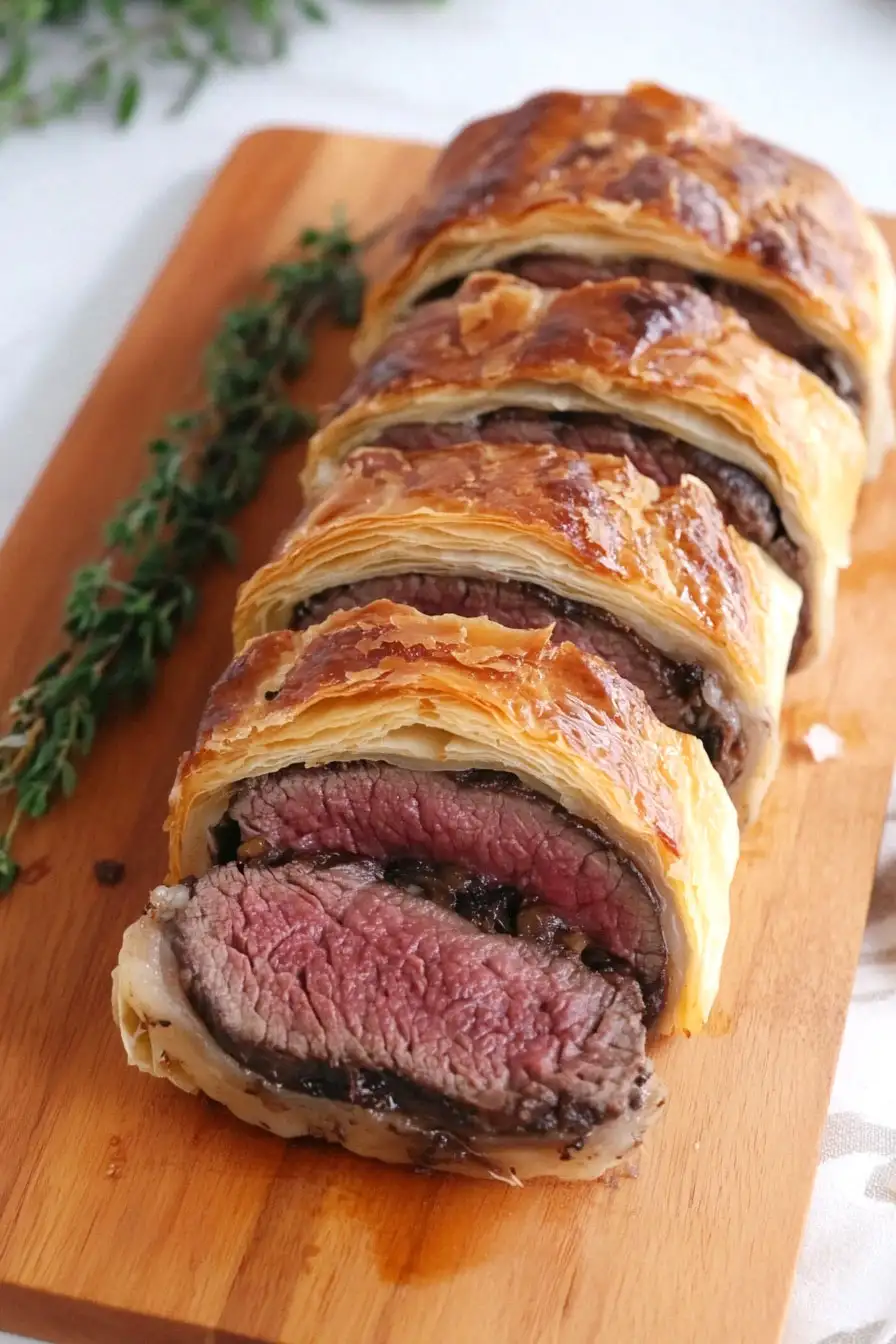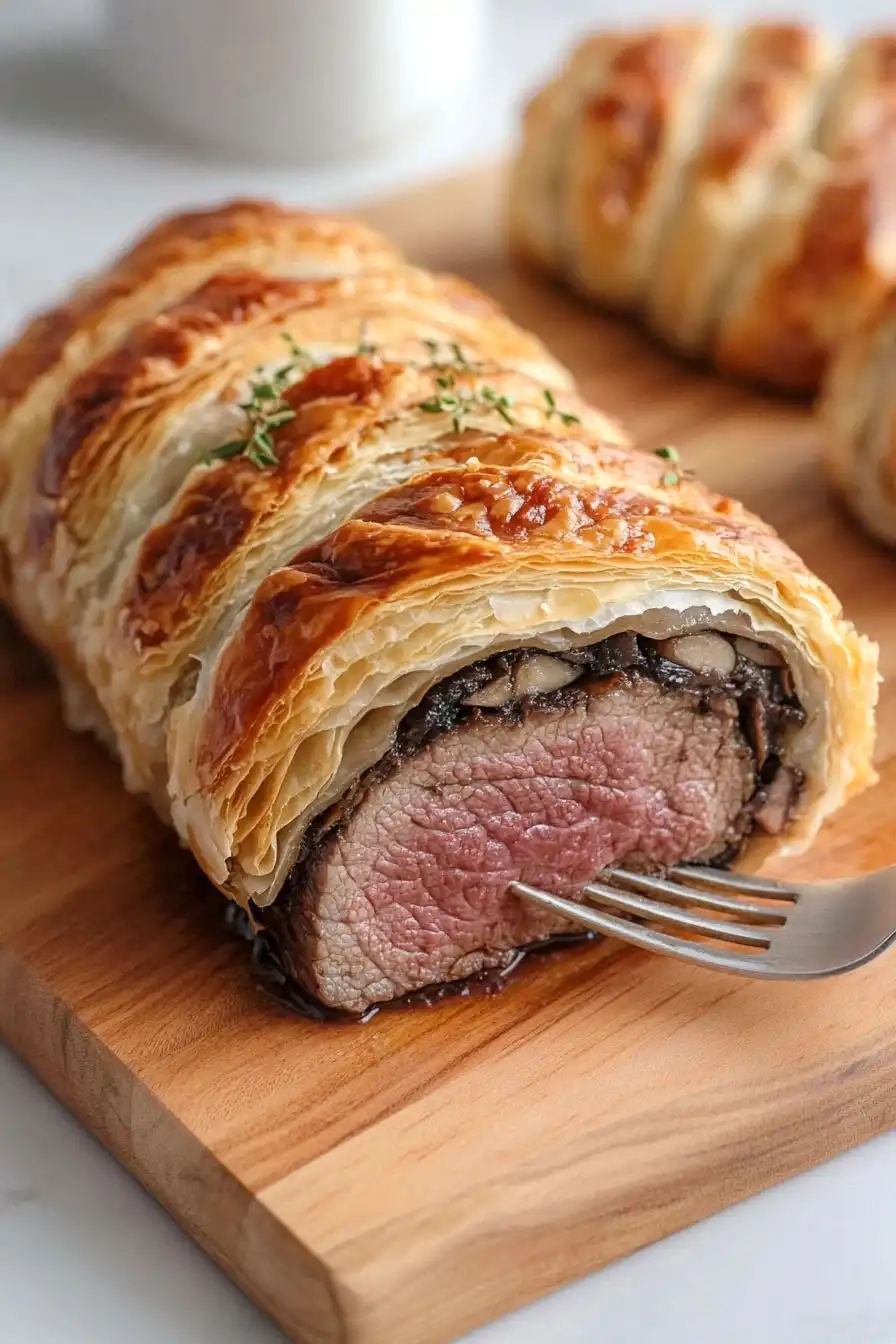Let’s talk about Beef Wellington – that fancy-looking dish that seems intimidating but is totally doable with the right approach. I remember the first time I made it, sweating bullets about getting the meat cooked just right. But then I discovered the sous vide method, and it was a game-changer.
Using sous vide for Beef Wellington takes away that stress of overcooking the meat. You get that perfect medium-rare every single time, and you can focus on nailing the other elements like the mushroom layer and that golden-brown puff pastry. Trust me, your dinner guests will think you spent all day in a professional kitchen.
Want to know the best part? You can prepare most of it ahead of time. I often get the beef sorted in the sous vide while I’m catching up on emails or helping the kids with homework. It’s the kind of recipe that looks impressive but doesn’t require you to be chained to the stove all day.

Why You’ll Love This Beef Wellington
- Restaurant-quality results – Using the sous vide method ensures your beef tenderloin is cooked perfectly every time – no more worrying about over or undercooking this special cut of meat.
- Foolproof preparation – While traditional Beef Wellington can be tricky, this sous vide version takes the guesswork out of achieving that perfect medium-rare center.
- Make-ahead friendly – You can sous vide the beef ahead of time and finish the assembly and baking when you’re ready to serve, making it perfect for entertaining.
- Impressive presentation – The golden-brown puff pastry wrapped around perfectly cooked beef makes this a show-stopping main course that’s sure to wow your guests.
What Kind of Beef Tenderloin Should I Use?
For beef Wellington, you’ll want to look for the center cut of beef tenderloin, also known as the châteaubriand. This premium cut comes from the middle of the tenderloin and is prized for its consistent shape and even cooking. When shopping, look for meat that’s bright red with minimal silver skin and some marbling, though tenderloin is naturally lean. Most grocery store meat counters will have this cut, but you might need to ask the butcher to prepare it specifically for Wellington – they can trim it properly and ensure you get that ideal cylindrical shape that’s about 2-3 inches in diameter. Just remember to bring your tenderloin to room temperature before starting your recipe, as this helps ensure even cooking throughout.

Options for Substitutions
While Beef Wellington is a classic dish that needs certain key ingredients, here are some possible swaps if you’re in a pinch:
- Beef tenderloin: This is really the star of the show and shouldn’t be substituted – the tenderness of this cut is essential for a proper Wellington. If you absolutely must, you could use center-cut beef ribeye, but the result won’t be quite the same.
- Puff pastry: Store-bought puff pastry is a huge time-saver, but if you can’t find it, you can use pie crust as a last resort. The texture will be different, but it’ll still work to wrap the meat.
- Crimini mushrooms: You can easily swap these with button mushrooms, portobello, or shiitake mushrooms. Just make sure to chop them finely and cook until all moisture is gone.
- Prosciutto: If prosciutto isn’t available, try using thin-sliced Serrano ham or regular deli ham. The main job is to create a barrier between the meat and pastry to prevent sogginess.
- Dijon mustard: Whole grain mustard works great here, or you could use regular yellow mustard in a pinch – just know the flavor will be slightly different.
- Shallot: No shallots? Use about 1/4 of a small onion plus one clove of extra garlic to get a similar flavor profile.
Watch Out for These Mistakes While Cooking
The biggest challenge when making Beef Wellington is preventing the dreaded “soggy bottom” – to avoid this, make sure your mushroom duxelles is cooked until completely dry and all moisture has evaporated, which usually takes about 15-20 minutes of careful cooking.
Temperature control is crucial with sous vide cooking, so don’t skip patting the tenderloin completely dry after it comes out of the water bath, as any excess moisture will create steam and prevent your puff pastry from getting crispy.
When wrapping the beef, ensure your prosciutto layer fully covers the meat with no gaps, creating a moisture barrier between the beef and pastry, and remember to chill the wrapped beef for at least 30 minutes before encasing it in puff pastry – this helps maintain the shape and prevents the butter in the pastry from melting too quickly.
A final but critical step is to cut small vents in the top of your pastry and brush with egg wash before baking, which allows steam to escape and creates that beautiful golden-brown crust.

What to Serve With Beef Wellington?
Since Beef Wellington is such a rich main dish, I like to keep the sides simple and let that beautiful pastry-wrapped tenderloin be the star of the show. A side of roasted asparagus or green beans adds a nice pop of color and freshness to balance out the richness of the beef and pastry. For something starchy, roasted baby potatoes or a simple mashed potato works great to soak up any extra sauce on your plate. If you’re feeling fancy, you might want to whip up a quick red wine sauce or mushroom gravy to serve alongside – though honestly, this dish is pretty amazing on its own!
Storage Instructions
Keep Fresh: If you happen to have leftover Beef Wellington (which rarely happens!), wrap it well in plastic wrap or place it in an airtight container. It will stay good in the fridge for up to 3 days. Just keep in mind that the pastry might lose some of its crispiness over time.
Make Ahead: You can prep your Wellington up to 24 hours before baking! After assembling, wrap it tightly in plastic wrap and keep it in the fridge. This actually helps the pastry stay cold, which is exactly what you want for that perfect golden crust. Just remember to bring it out about 15 minutes before baking.
Warm Up: To enjoy your leftover Wellington, heat it in a 350°F oven for about 10-15 minutes. I don’t recommend microwaving as it’ll make the pastry soggy. If you’re reheating individual slices, 8-10 minutes should do the trick. The goal is to warm it through without overcooking the meat.
| Preparation Time | 30-45 minutes |
| Cooking Time | 120 minutes |
| Total Time | 150-165 minutes |
| Level of Difficulty | Medium |
Estimated Nutrition
Estimated nutrition for the whole recipe (without optional ingredients):
- Calories: 1600-1800
- Protein: 100-110 g
- Fat: 100-110 g
- Carbohydrates: 30-40 g
Ingredients
- 1 pound beef tenderloin fillet
- Salt and pepper for seasoning
- 2 tablespoons dijon mustard
- 1 sheet puff pastry, thawed
- 8 ounces crimini mushrooms
- 1 shallot, finely diced
- 3 garlic cloves, minced
- 1 tablespoon unsalted butter
- 6 slices of prosciutto
Step 1: Prepare and Cook the Beef
Begin by setting the Anova Sous Vide Precision Cooker to 124°F (51°C).
Season the beef tenderloin generously with salt and pepper, ensuring even coverage.
Place the seasoned beef in a vacuum bag or a resealable ziplock bag.
Submerge the bag in the water bath and cook the beef for 2 hours to achieve a perfectly tender texture.
Step 2: Prepare the Mushroom Duxelles
While the beef is cooking, finely chop the crimini mushrooms using a food processor or by hand.
In a hot pan, sauté diced shallots and chopped garlic until soft and fragrant.
Add the chopped mushrooms to the pan and cook until all the water has evaporated.
Then, incorporate 1 tablespoon of unsalted butter, stirring until thoroughly combined to create a savory mushroom duxelles.
Step 3: Sear the Beef Tenderloin
After the sous vide process is complete, remove the beef from the bag and pat it dry with paper towels, ensuring the surface is as dry as possible for effective searing.
Heat oil in a cast-iron pan until it is shimmering.
Sear the beef tenderloin on all sides until it achieves a golden brown crust, about 30 seconds per side.
Once seared, spread dijon mustard evenly over the entire surface of the tenderloin.
Step 4: Wrap with Prosciutto and Mushroom Duxelles
Lay a piece of plastic wrap on a flat surface.
Arrange the prosciutto slices horizontally on the plastic wrap, ensuring each slice slightly overlaps the next to form a continuous layer.
Spread the mushroom duxelles thinly over the prosciutto, creating a consistent layer.
Carefully place the seared and mustard-coated tenderloin on top of the duxelles at one end of the prosciutto arrangement.
Step 5: Roll and Finalize Preparation
Using the plastic wrap to assist, slowly and gently roll the tenderloin over the mushroom and prosciutto layers to enclose it fully.
The plastic wrap will help maintain a tight roll.
Once rolled, keep the beef wrapped and refrigerate until you’re ready to proceed with further cooking or serving.
This preparation will infuse the rich flavors of the prosciutto and mushroom into the beef, enhancing its taste.

